Some years ago I wrote here about the my first two small sailboat projects, Grace O`Malley and Stella. After those projects I then decided to build a bigger boat. I first bought drawings for John Welsford´s Pathfinder, and that was my inspiration for the design I made, a two-masted 17,5 foot plywood clinker version that I named Shannon. Since I have never built a plywood clinker boat and no boat in that size, the building process took a lot of time and I also made some mistakes. And of course another reason for the long time is that here in the north of Sweden if you have no heated boathouse, the building work can only be done during three or four months in the summer.
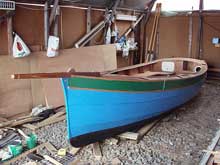 |
Here in the north of Sweden if you have no heated boathouse, the building work can only be done during three or four months in the summer. |
I ordered the computer program Plyboats to create the shape of the sideplanks, but I made a mistake in not realizing that since that program only defines the stem, widest part and stern there could be some difference in the shape between these three pionts. So my mistake was that I only added less than half an inch on the width of the sideplanks.
And when I had ordered the pre-cut sideplanks and was to add them on there was a gap of around half an inch between the sideplanks in the aft area, so I had to order a new set of wider pre-cut sideplanks.
As for the rig I decided to make batwing sails with a special kind of “gaff saddle” attached to the mast. The saddle is laminated from a lot of plywood pieces and has a vertical rear part with two holes where one spar can be attached on each side, so it can take altogether four spars. With the sail raised the saddle position will be a bit above the centre of the mast. Another advantage with this rig is that the top spar and sail can go well above the mast, just like a gunter rig, so the mast can be a bit shorter to make the boat a little bit more stable.
| As for the rig I decided to make batwing sails with a special kind of “gaff saddle” attached to the mast. |
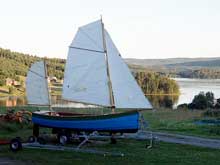 |
Unfortunately, the mainsail was to be cut out from an old bermudan sail, and that sail was a bit too narrow to get the shape that I had designed, so I could only put three spars on the mainsail, but four spars on the mizzen. The mainsail area is 8,5sqm, the jib 3sqm and the mizzen 2,5sqm.
Another problem with small boat yawl rigs is that the mizzen mast interferes with the tiller. The established solutions are either tillers that are split into two wide curves going around the mizzen, tillers that end just behind the mizzen and are operated back there by the helmsman, a somewhat awkward steering position, or the mizzen mast positioned on the side of the tiller. Since I had tried the line-steering principle on my first small gaffers with good result I decided to try the same solution here, and it seems to work just as good in this size, too.
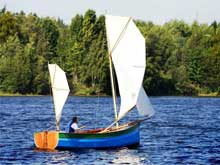 |
Unfortunately, the mainsail was to be cut out from an old bermudan sail, and that sail was a bit too narrow to get the shape that I had designed |
Another idea that popped up in the process was a brand new way to attach the mizzen sheet. I drilled a small hole in the centre of the tiller just above the upper gudgeon. A line is to be attached to the transom just beneath the same gudgeon, and just long enough to put a loop through the hole so the mizzen sheet can be snapped on to it. This way it has an extra function: It secures the rudder.
When the hull was finished, I decided to epoxy on another plywood layer to the inside of the bottom to make it stronger. But I had only a number of rather small plywood pieces left, so I had to glue them on like a jig-saw puzzle. And before I did that, I should have checked that there was no leakage in the connection between the bottom and the centreboard case.
So when I launched her the first time there was a lot of water coming in. I noticed where the leakage was and filled it with epoxy but then the water just took another way between the two bottom planks and came out somewhere else. So it took quite a long time until I had all the leakage fixed.
| I made air-tight floating compartments at the bow and stern and to make it even more safe I have filled those compartments with a lot of 3-litre winebags (filled with air, not wine). |
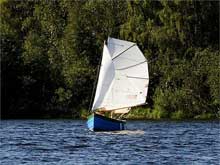 |
And when that problem was OK and I could begin to sail her I noticed that when sailing with the wind from the side she wanted to turn downwind, one reason for that may be that the centre of the sailarea is too far ahead. And another reason could be that she has a flat bottom and is quite light, so the draught with ony me aboard is maybe only three inches, and less then that in the front part. And I had added a skeg only in the aft part, which could be another reason. So this coming summer I will try again with a forward skeg added, a jib that is reduced from 3sqm to 2,5sqm and a batwing mizzen sail that is increased from 2.5sqm to 3.3sqm.
I made air-tight floating compartments at the bow and stern and to make it even more safe I have filled those compartments with a lot of 3-litre winebags (filled with air, not wine).
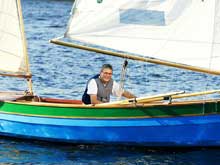 |
For those who are interested, I can mail you the drawings as dxf-files for free. |
Since I can only work (or sail) with my boats in the summer I have been looking for something to do during the winter, and came up with the idea to design a number of open boats to fill all the size gaps between Stella and Shannon. That means different hulls in sizes from 7´8” to 20´. There will be 16 sizes, but every size will be made for both strip-planking and plywood clinker, so I will design 32 different hulls. So far I have finished 24 of them, and the last 8 will be done next winter. For those who are interested, I can mail you the drawings as dxf-files for free.
There is a homepage with information about all those designs: https://web.comhem.se/chby/segling/design.htm
Here is my sailing link page:
https://web.comhem.se/chby/segling/lankar.htm
My e-mail address is: chrbys@gmail.com
Christer Byström
Umeå
Sweden
*****
More Articles by Christer Byström
|

